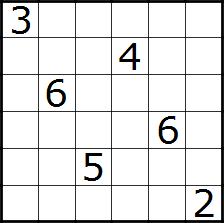This post will contain puzzles I wrote as a team round for the UKPA Open. It wasn't an official round. It was more t give the puzzlers some practise in team solving while the organisers finished the final checking. I haven't much idea on the results. I wrote the round in two days and sent it in to Liane two days before the Championship was held; just in time for them to get it ready to be solved. I didn't have time to get it tested, but I hope people still enjoyed it.
The structure of the round is pretty simple. There are six 6 by 6 puzzles and six 10 by 10 puzzles. You are not given the rules of each specific puzzle, but are instead provided with six sets of rules under which each puzzle could be solved. You have to match the puzzles to the rules, so that each rule is used once for each size. Additionally, all 10 by 10 puzzles have a marked 6x6 hole, in which the clues of one of the 6 by 6 puzzles have to be placed, without reflection or rotation. Each 6 by 6 grid can only be placed in one of the 10 by 10 grids. The rules for 6 by 6 puzzle won't necessarily match the rules for the 10 by 10 puzzle it is placed in.
Puzzles found below or through the following link.
Puzzle Rules
Battleships Observers:
Place a fleet of ships in the grid. For the 6x6 grid the fleet is 1 Cruiser (Size 3), 2 Destroyers (Size 2) and 3 Submarines (Size 1). For the 10x10 grid the fleet is 1 Battleship (Size 4), 2 Cruisers, 3 Destroyers and 4 Submarines. The ships are not allowed to touch each other, not even diagonally. Numbers in the grid indicate the amount of empty cells that can be seen in all four directions from this cell, not including the cell itself. Clue cells count as empty cells for other clue cells.
Cave(/Corral):
Shade some cells to form a single connected group – the cave - with no enclosed white cells. In other words, all white cells must be connected by other white cells to an edge of the grid. All numbered cells must be a part of the cave, with each number indicating the total count of cells connected vertically and horizontally to the numbered cell, including the cell itself.
Draw one or more horizontal or vertical lines from each numbered clue so that all blank cells are connected to exactly one of the numbers. Lines cannot enter other numbered squares or intersect with other lines. Each number represents the total number of blank cells occupied by the lines from that number.
Shade some cells to form a single orthogonally connected island. All clues are part of the island. Numbers indicate the amount of shaded cells that can be reached from this cell without passing any other numbered cells.
Draw a single closed loop through the grid that travels horizontally and vertically so that it doesn’t touch or cross itself. Numbers in the grid indicate how many of the eight cells around it are used by the loop.
Shikaku:
Divide the grid into a number of rectangular regions along the grid lines. Each region must contain exactly one number. This number indicates the size of the rectangle.
6 By 6 Puzzles
Puzzle 1
Puzzle 2
Puzzle 5
Puzzle 6
10 by 10 puzzles
Puzzle 1
Puzzle 2
Puzzle 3
Puzzle 4
Puzzle 5
Puzzle 6












We split into teams of 3-4 players for this round (mostly 4s). Like all the puzzles at the Open, this was a very enjoyable set - thank-you Bram!
ReplyDelete